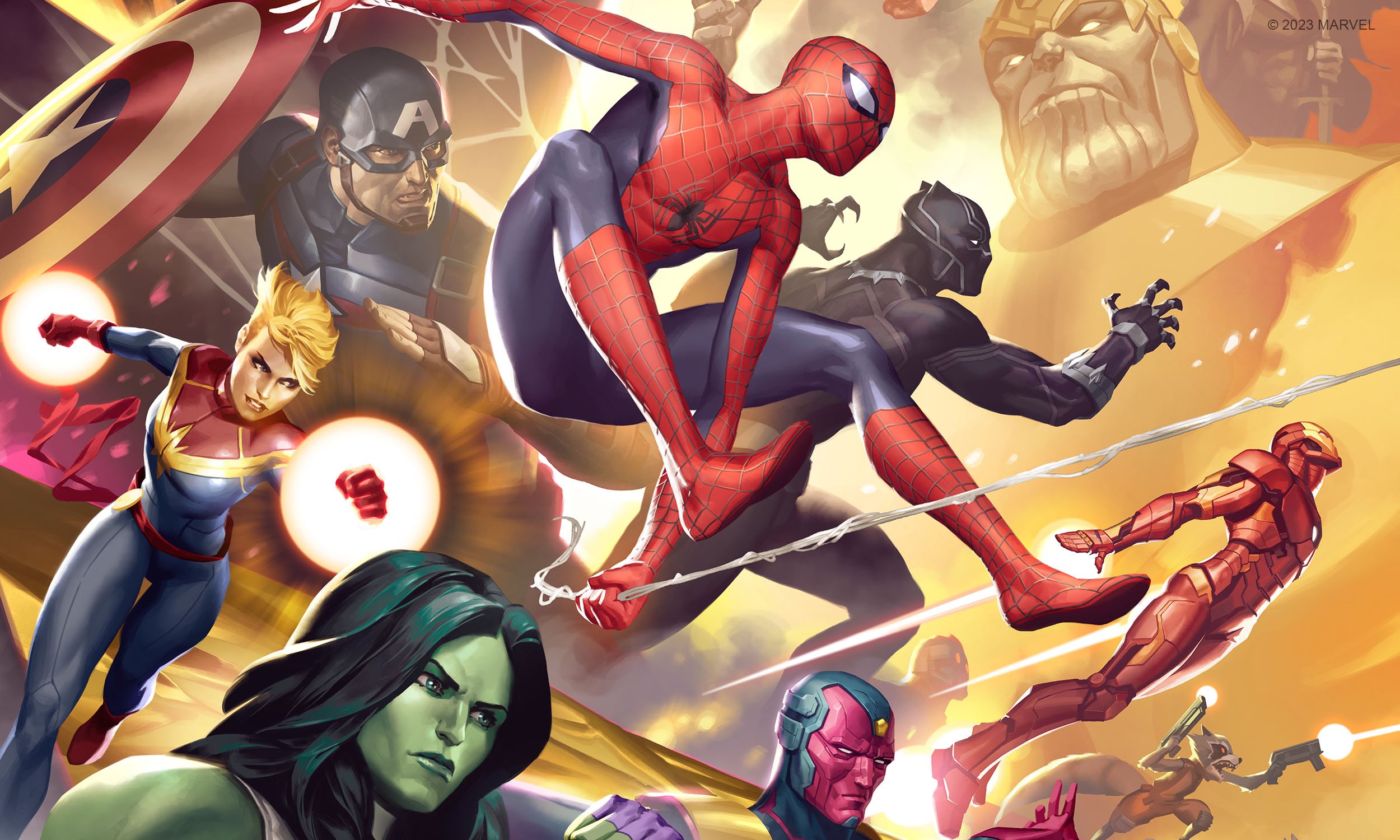-
- Some services are not accessible on smartphone
- Open a session
- My Account
- Customer Service
-
Products
-
Pre-orders
Pre-orders
- Featured Pre-orders
- All Pre-orders
- 2024 - Week 18 (Apr. 29)
- 2024 - Week 17 (Apr. 22)
- 2024 - Week 16 (Apr. 15)
- 2024 - Week 15 (Apr. 8)
- 2024 - Week 14 (Apr. 1)
- 2024 - Week 13 (Mar. 25)
- 2024 - Week 12 (Mar. 18)
- 2024 - Week 11 (Mar. 11)
- 2024 - Week 10 (Mar. 4)
- 2024 - Week 9 (Feb. 26)
- 2024 - Week 8 (Feb. 19)
- 2024 - Week 7 (Feb. 12)
- 2024 - Week 6 (Feb. 5)
- 2024 - Week 5 (Jan. 29)
- New Releases
- Fantasy Flight
- Board Games
- Miniatures
- Collectible Card Games
- Books
- Dice
- Puzzles
- Roleplaying Games
- Supplies
- Decor
- Toys
- Plushies
- Clearance
- All
-
Pre-orders
- Featured at Canada Plays
- Publishers
- New Releases
- Pre-orders
- Magic Deals
- Clearance
- Contact Us
- FAQ
- Application Request
Building a Hero
Article written by FFG and reproduced here with permission - April 24, 2023
Guest Writer Jake Egglesden Talks About Deckbuilding in Marvel Champions: The Card Game
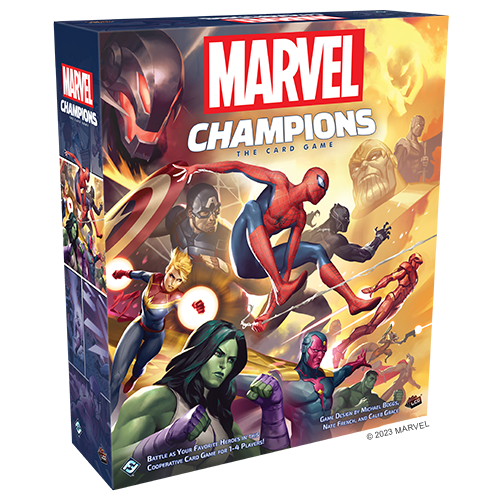
There are few things more enjoyable than facing off against a dastardly villain and defeating them, but winning with a deck that you personally put together? Now that’s satisfying! But to do so, we must answer a question as old as the very genre of deck-building itself: “How do I build a deck?”
In a game with dozens of heroes and hundreds of cards, the prospect of building your own deck can be daunting to say the least. In this article, I will show you how to break this big question down into smaller, easy-to-digest pieces and share my process of how to build a successful deck.
The Basics of Deckbuilding
So, where do you begin? If you are inspired by something, such as a fun idea about how a certain upgrade would work with a certain hero, you can begin by adding that upgrade to their deck and then looking for cards that interact with it! Otherwise, you might choose a hero you like and look at their strengths and weaknesses to determine which cards you might add; we will be focusing on this method here.
Now, before you can know what you should add to a deck, it’s important to know what you can add to a deck! So, let’s place all the hundreds of cards in Marvel Champions into three broad categories:
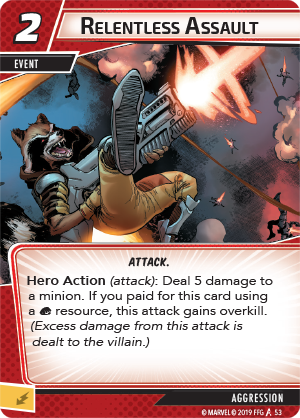
Damage. These cards are often attack events, upgrades that boost your ATK stat, or cards which offer alternative ways to deal damage.
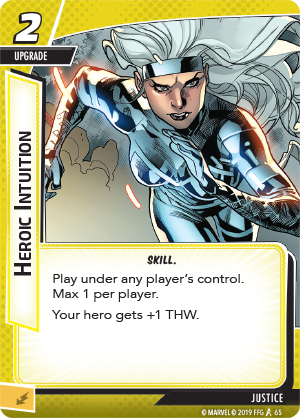
Threat Removal. These cards include thwart events, cards that boost your THW stat, and cards which prevent threat from being added to a scheme in the first place.

Survivability. These cards prevent damage, stun enemies, restore hit points, increase your maximum hit points, or increase either your DEF or REC stats.
There are more categories we could identify, and we could further break these three down, but for the sake of simplicity these make an excellent place to begin. While they might seem obvious, the trick is knowing how much to add from each category. And for that, we need to ask ourselves a new question: “What player count is my deck for?”
Are you planning to use your deck in a solo game? If so, you have only yourself to rely on to deal with all the different things the scenario is throwing at you. If building for yourself alone, your deck needs to be an independent all-rounder to handle each of the above three categories.
Are you planning to use your deck in multiplayer? If so, then you’ll have other players to rely on! This means you are free to specialize in a role such as “threat remover.” Doing so is generally very efficient, and makes your resources go further. The more players you have, the less well-rounded your deck needs to be and the more you can focus on being a master of one category.
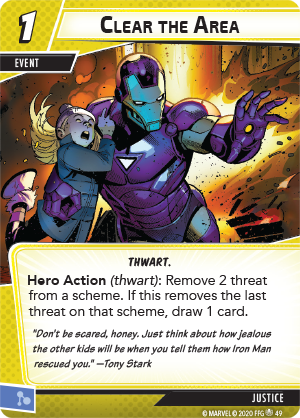
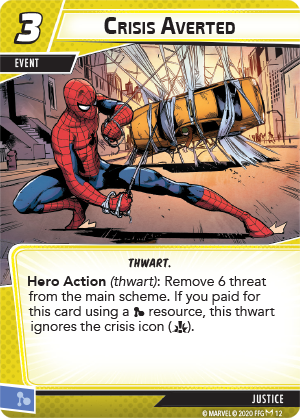
Some cards are also better at certain player counts. For example, let’s look at Clear the Area (The Rise of Red Skull, 49). This card removes 2 threat and, if it removes the last threat on a scheme, you draw a card. Clear the Area is at its best in solo play since schemes typically gain threat per player; the fewer players, the lower the threat, and thus the easier it is to have Clear the Area remove the last of it and draw you a card.
On the opposite side, we have Crisis Averted (Scarlet Witch, 12), acard which removes 6 threat from the main scheme. In solo play, many of the main schemes do not even go up to 6 threat, and so using this card would lead to wasted threat removal. In multiplayer, however, there tends to be plenty of threat to remove. Also, with more players come more encounter cards, making Crisis Averted’s ability to avoid crisis icons more useful.
In short? In solo play we want to build a well-rounded deck that is able to deal damage, remove threat, and defend itself. In multiplayer, we are free to specialize in a role and use cards with larger effects. If you want a deck for any player count, you can always make a solo-style deck and, when playing with others, simply ensure everyone else also brings a well-rounded deck.
Now, to really elevate your deck, you should build it around your hero! And, to do this, we need to ask ourselves another question: “What are my hero’s strengths and weaknesses?”
Most heroes consist of a single identity card and their 15 signature cards, and it’s through these that they gain their various strengths and weaknesses. The best way to understand a hero is to experience playing as them, but there are a few shortcuts which we’ll cover here.
First, we need to introduce one more category of cards:
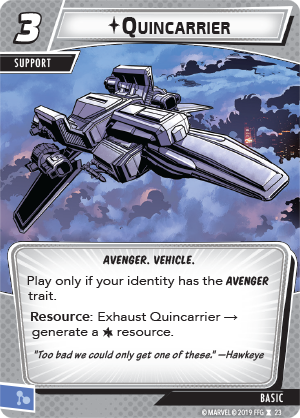
Economy.These cards generate resources, discount costs, or draw you cards.
A strong card economy can elevate everything else in your deck. For example, your economy won’t directly deal damage to the villain, but a strong economy will let you play more of your damage-dealing cards more often!
Let’s take our four categories of cards and apply them to heroes. We want to identify whether a hero has any weaknesses or strengths among the categories of damage, threat removal, survivability, and economy.
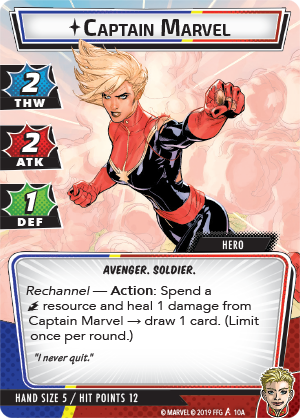
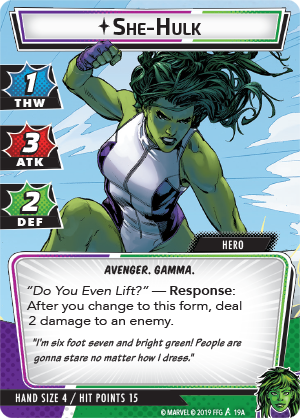
Is a hero’s best stat their THW and/or they have several ways to remove threat on their identity or signature cards? Threat removal is likely a strength of theirs. If their THW stat is low and they do not have much threat removal in their signature cards, threat removal is a weakness. The same logic can be applied to the other categories and their corresponding stats!
Economy differs from the others as it also includes hand size. Heroes with a hand size of 4 or lower almost always have economy as a weakness, while heroes with multiple ways to generate resources/draw cards are likely to have it as a strength. Identity card abilities that generate resources/draw cards are also a sign of strong economy, as are any signature resource cards.
Take note that total a hero’s hit points and our alter-ego’s REC stat also contribute to survivability and, more importantly, that no two heroes are alike; there are exceptions everywhere! The best way to learn really is to experience playing the character.
Once we have a good idea of where our hero’s strengths and weaknesses fall across the four categories, it’s time to add some cards. If we’re building for solo play, we want to make the deck well-rounded, so it’s important to first cover our weaknesses before adding to our strengths. Thor (Thor, 1A) is a hero with high damage but low threat removal, and so, when playing him alone, he loves the Justice aspect to give him thwarting cards!
On the other hand, for multiplayer, if a hero such as Thor has high damage but low threat removal, they would make a great fit in Aggression! Boost their damage by including attack cards and/or ATK boosts; you can leave the threat removal to the Justice and/or Leadership player.
If you judge your hero to be an all-rounder, you can easily build them in any aspect! And you can of course play any hero in any aspect; it is simply the case that certain heroes have to work harder in certain aspects. But don’t be discouraged! Sometimes, building a hero in an unusual aspect for them can lead to the most unique and rewarding decks.
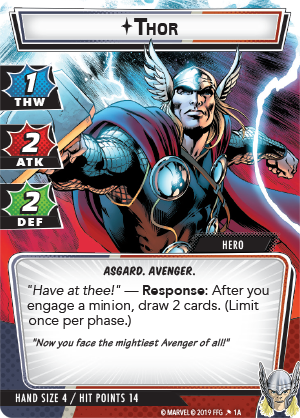
So, now we know how to identify our hero’s strengths/weaknesses and how to best build a deck around them. But which cards should you actually add? And how many of each type?
For this we need to ask, “What does each type of card bring to my deck?”
Previously, we’ve used four categories - damage, threat removal, survivability, and economy - to describe cards and heroes alike. Now we need to delve a little deeper and look at some official player card types: events, supports, upgrades, allies, and resources. By understanding what each type does for us mechanically, we can learn how many of each type we need to add to our deck during deck-building.
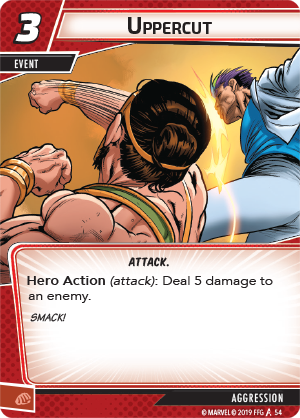
Events generally provide an instant effect, or an effect that lasts until the end of the phase or round. These cards offer high immediate value and are short-term gains.
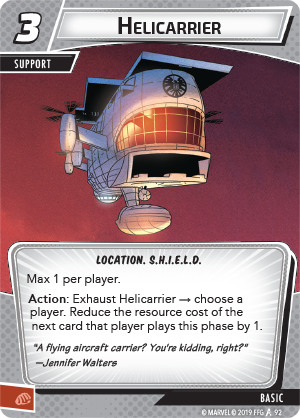
Upgrades and supports typically provide a permanent benefit. They tend to offer low immediate value but high long-term gain.
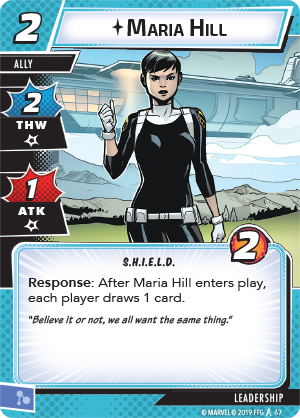
Allies have a limited amount of uses due to taking consequential damage when using their THW or ATK (their hit points can largely be thought of as their total amount of uses). They tend to offer more immediate value than upgrades/supports, but less immediate value than events.
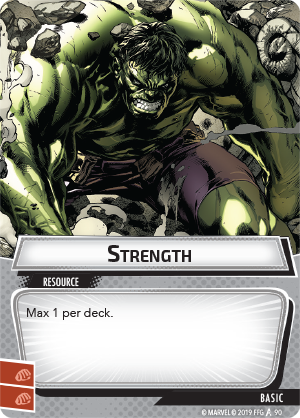
Resources pay for other cards. They cannot themselves be played, but they offer extra value when they are discarded to generate resources. Each typically increases your deck’s economy at the expense of providing you one less option in your hand.
To put it simply: events are short-term gains, allies are medium-term gains, and supports/upgrades are long-term gains, while resources simply help you to play the other types of cards.
The key to victory lies in the careful balance of these different card types. Play too slowly, with too many upgrades/supports, and you may be quickly overwhelmed. If you have too many resources, you may end up with a hand of resource cards and nothing to pay for! Too many allies? You may reach the ally limit and struggle to get full value from them.
So, is there a magic recipe with the correct amount of each card type you should always aim for? The short answer is no; there are almost countless ways to build a great deck! Every hero is different, and a deck that does well against one scenario might not do as well against another.
However, there are some guidelines you can use as a template when starting out. Just remember that decks can be built in infinite ways; you are highly encouraged to experiment once you get the hang of it!
As a starting point for deckbuilding, I recommend including the following quantities of each type (including the cards in your hero’s signature kit):
- Events: 14-21 cards
- Upgrades/Supports: 7-13 cards
- Allies: 4-8 cards
- Resources: 3-7 cards
Note that the average Leadership deck tends to prefer more allies (roughly 8-12) and fewer events, while Protection often likes to have more upgrades/supports and fewer allies. And you should be aware that survivability can be added through both events and upgrades when building in Protection, while the other aspects tend to prefer allies to help defend themselves.
As a general rule, I recommend always adding the Energy (Core Set, 88), Genius (Core Set, 89), and Strength (Core Set, 90) resource cards. Also, at least one upgrade/support that boosts your economy, such as Helicarrier (Core Set, 92), even if a hero already has a strong economy! If a hero has a weak economy, you may want to add 2-4 of these “resource generators” such as Quincarrier (Black Widow, 23), Deft Focus (Galaxy’s Most Wanted, 24), or Sense of Justice (Quicksilver, 30).
I also recommend including more 0, 1, and 2-cost cards than 3+ cost cards. Cheaper cards allow you to play your whole hand more easily each turn, and you almost always want to play everything. With a hand size of 5, leaving a card unspent in your hand is roughly equivalent to losing 20% of the resources in that hand. While the more expensive cards can be very good, try to avoid taking too many.
Example Deck: Spider-Man (Justice)

Let’s go through this process step-by-step with our friendly neighborhood Spider-Man (Core Set, 1A) as an example.
Firstly, we’ll say we’re looking to build this deck for solo play. Looking at the basic powers on his identity card, we can see Spidey has a THW stat of 1, an ATK of 2, and a DEF stat of 3, as well as resource generation on his alter-ego side and card draw in his hero form. We can also see from his signature cards that he has several survivability cards but little threat removal.
With his DEF as his best stat and many survivability cards, we can identify survivability as a huge strength for Spidey. Also, from a combination of his alter-ego ability, hero ability, and two resource generating cards, we can see Spider-Man has a strong economy. However, Spider-Man is a low threat removal hero with just a THW stat of 1 and few thwarting cards.
As a solo deck, we should start by covering our weaknesses. For Spidey, that clearly means threat removal, and the easiest way to add it is through building a deck in the Justice aspect! Let’s start with that and add the following thwart events: 3 copies of Clear the Area and 3 copies of For Justice! (Core Set, 60).
Then we can look at adding damage. With an ATK of 2 and three attack events, Spider-Man’s damage is average, but a hero should never settle for average! Let’s add 3 copies of Turn the Tide (Scarlet Witch, 15) and 3 copies of Stealth Strike (Black Widow, 13). The great thing about Stealth Strike is that it often removes threat as well, further covering for Spidey’s weak threat removal while still adding to his damage options.

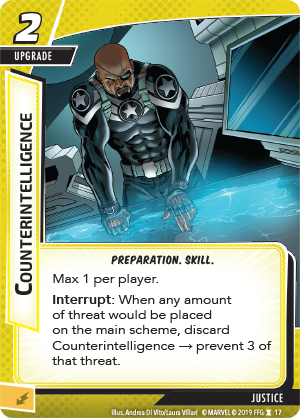
Next, we can try to reinforce these categories through allies. Let’s add Quake (Black Widow, 12) for damage, Agent Coulson (Black Widow, 11) for threat removal, and Wiccan (Scarlet Witch, 11) and Daredevil (Core Set, 58) for a little of both. Since we have Agent Coulson and he interacts with Preparation cards, we should add one! Let’s add the Preparation upgrade Counterintelligence (Black Widow, 17) as yet another way to help Spidey deal with threat.
With his weakness of threat removal thoroughly accounted for, as well as some solid damage, we can spare a few cards to increase Spider-Man’s economy. Support cards Avengers Mansion (Core Set, 91) and Quincarrier are extremely versatile, and we can also add a Skilled Investigator (The Rise of Red Skull, 47) to profit from side schemes.
Last but not least, now that we have a total of 11 Justice cards with a cost of 2 or higher, we can add in 2 copies of The Power of Justice (Core Set, 62) alongside Energy, Genius, and Strength as a final boost to our deck’s economy. Also note how we have not aimed to increase our survivability—this is because it is both already excellent, and our allies can always defend us in a pinch.
When you include Spider-Man’s 15 signature cards, this brings our deck to 19 events, 5 allies, 11 upgrades/supports, and 5 resource cards. These all fall within our earlier guidelines and neatly form a deck of 40 cards. And so, our deck is finished!
If you wish to build this deck, all that is required to build it are the following four products: the core set, The Rise of Red Skull expansion, and the Black Widow and Scarlet Witch hero packs:

My final and yet perhaps most valuable piece of advice is this: test your deck! Try it out and see what works and what does not. Do not be disheartened if your first attempt leads to a loss; Rome was not built in a day! Is there is a card you keep seeing but never play? Remove it. Are you struggling with schemes? Add more threat removal! Do you often end up with expensive cards left in your hand that you are unable to play? Replace them with cheaper options. Then give the deck another try!
In conclusion, with over 40 heroes and hundreds of cards now released in Marvel Champions, there are nearly endless possibilities for decks to build. Simply put, there is no better time to start deckbuilding! Start with the basics, then try looking for synergies between cards and see where it takes you.
I hope this has helped you with building decks. Good luck out there!
Written by Jake Egglesden, aka VillainTheory

